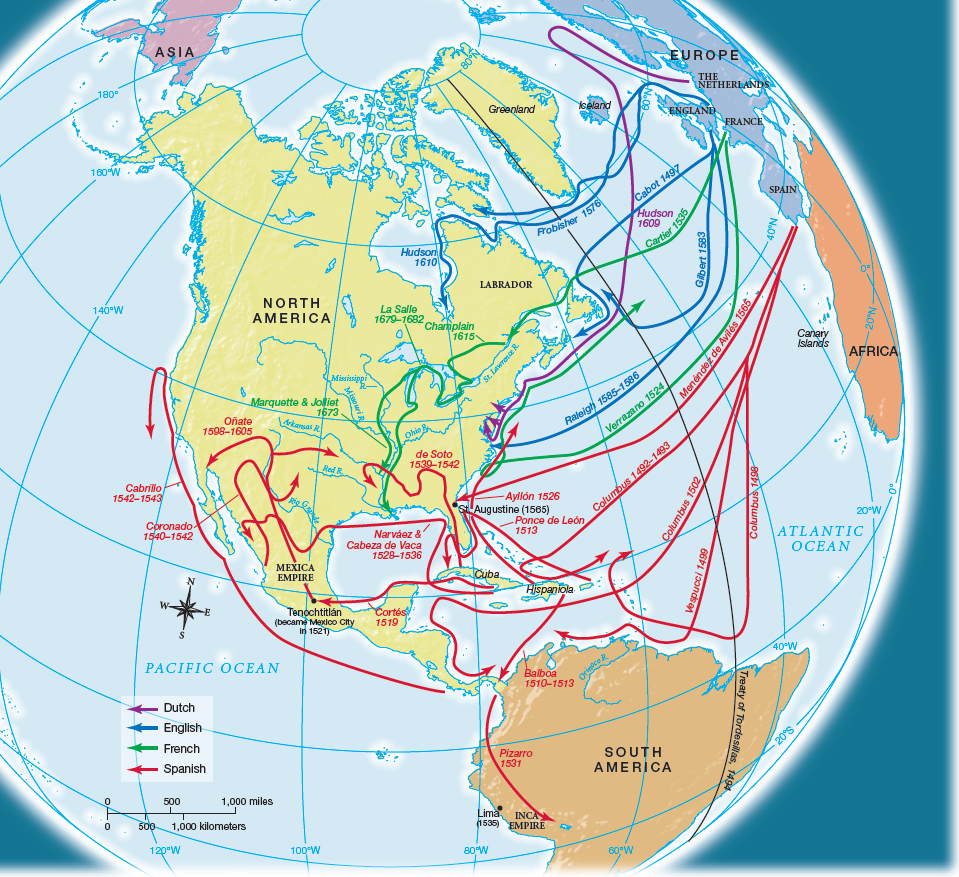The Geographic Revolution and the Columbian Exchange
Printed Page 36
Section Chronology
Within thirty years of Columbus’s initial discovery, Europeans’ understanding of world geography underwent a revolution. An elite of perhaps twenty thousand people with access to Europe’s royal courts and trading centers learned the exciting news about global geography. But it took a generation of additional exploration before they could comprehend the larger contours of Columbus’s discoveries.
By 1500, European experts knew that several large chunks of land cluttered the western Atlantic. A few cartographers speculated that these chunks were connected to one another in a landmass that was not Asia. In 1507, Martin Waldseemüller, a German cartographer, published the first map that showed the New World separate from Asia; he named the land America, in honor of Amerigo Vespucci.
Early Voyages to the Americas
> Early Voyages to the Americas
| Explorer | Voyage |
| John Cabot | Reached Newfoundland in 1497 while searching for a Northwest Passage to Asia. |
| Amerigo Vespucci | Participated in a Spanish expedition that landed on the northern coast of South America in 1499. |
| Pedro Álvars Cabral | Commanded a Portuguese fleet bound for the Indian Ocean that accidentally made landfall on the coast of Brazil. |
Two additional discoveries confirmed Waldseemüller’s speculation. In 1513, Vasco Núñez de Balboa crossed the Isthmus of Panama and reached the Pacific Ocean (Map 2.2). Clearly, more water lay between the New World and Asia. Ferdinand Magellan discovered just how much water when he led an expedition to circumnavigate the globe in 1519. Sponsored by Spain, Magellan’s voyage took him first to the New World, around the southern tip of South America, and into the Pacific. Crossing the Pacific took almost four months, decimating his crew with hunger and thirst. Magellan himself was killed by Philippine tribesmen. A remnant of his expedition continued on to the Indian Ocean and managed to transport a cargo of spices back to Spain in 1522.

In most ways, Magellan’s voyage was a disaster. One ship and 18 men crawled back from an expedition that had begun with five ships and more than 250 men. But the geographic information it provided left no doubt that America was a continent separated from Asia by the enormous Pacific Ocean. Magellan’s voyage made clear that it was possible to sail west to reach the East Indies, but that was a terrible way to go. After Magellan, most Europeans who sailed west set their sights on the New World, not on Asia.
Columbus’s arrival in the Caribbean anchored the western end of what might be imagined as a sea bridge that spanned the Atlantic, connecting the Western Hemisphere to Europe. Somewhat like the Beringian land bridge traversed by the first Americans millennia earlier (see chapter 1), the new sea bridge reestablished a connection between the Eastern and Western Hemispheres. The Atlantic Ocean, which had previously isolated America from Europe, became an aquatic highway, thanks to sailing technology, intrepid seamen, and their European sponsors. This new sea bridge launched the Columbian exchange, a transatlantic trade of goods, people, and ideas that has continued ever since.
Columbian exchange
 The transatlantic exchange of goods, people, and ideas that began when Columbus arrived in the Caribbean, ending the age-old separation of the Eastern and Western Hemispheres.
The transatlantic exchange of goods, people, and ideas that began when Columbus arrived in the Caribbean, ending the age-old separation of the Eastern and Western Hemispheres.
Spaniards brought novelties to the New World that were commonplace in Europe, including Christianity, iron technology, sailing ships, firearms, wheeled vehicles, and horses. Unknowingly, they also carried many Old World microorganisms that caused devastating epidemics of smallpox, measles, and other diseases that killed the vast majority of Indians during the sixteenth century and continued to decimate survivors in later centuries. European diseases made the Columbian exchange catastrophic for Native Americans. In the long term, these diseases helped transform the dominant peoples of the New World from descendants of Asians, who had inhabited the hemisphere for millennia, to descendants of Europeans and Africans, the recent arrivals from the Old World.
Ancient American goods, people, and ideas made the return trip across the Atlantic. Europeans were introduced to New World foods such as corn and potatoes that became important staples in European diets, especially for poor people. Columbus’s sailors became infected with syphilis in sexual encounters with New World women and unwittingly carried the deadly bacteria back to Europe. New World tobacco created a European fashion for smoking that ignited quickly and has yet to be extinguished. But for almost a generation after 1492, this Columbian exchange did not reward the Spaniards with the riches they yearned to find.
CHAPTER LOCATOR
What factors led to European exploration in the fifteenth century?
What did Spanish explorers discover in the western Atlantic?
How did Spaniards explore, conquer, and colonize New Spain?
What impact did Spain’s New World endeavors have in Europe?
Conclusion: What promise did the New World offer Europeans?
 LearningCurve
LearningCurve
Check what you know.
bedfordstmartins.com/roarkunderstanding
QUICK REVIEW